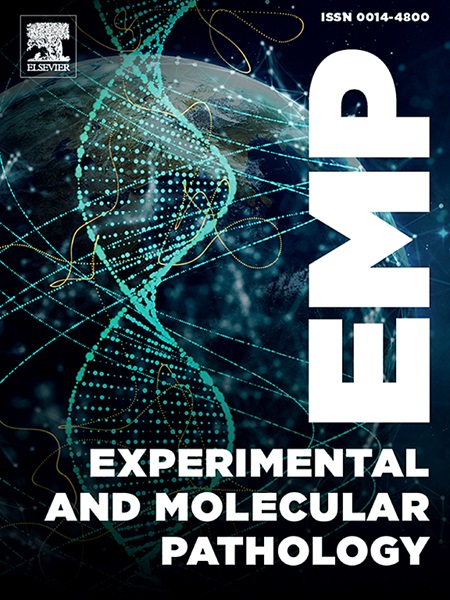β-地中海贫血/HbE病无效红细胞生成过程中的代谢重编程
IF 3.7
4区 医学
Q2 PATHOLOGY
引用次数: 0
摘要
无效的红细胞生成是β-地中海贫血病中贫血的主要原因,其特征是红母细胞急剧扩增和红母细胞死亡增加。β-珠蛋白链的缺失或减少导致过量α-珠蛋白链的积累,产生细胞毒性反应性氧化物质,导致红母细胞死亡。新陈代谢提供能量,为大分子合成提供基石,并为抗氧化防御系统提供辅助因子。我们假设β-地中海贫血红细胞可能改变其代谢以应对增加的增殖和细胞应激。本研究通过对β-地中海贫血/HbE患者骨髓分离的嗜碱性和多色红细胞的转录组学分析发现,糖酵解、TCA循环、戊糖磷酸途径、ATP和脂肪酸合成途径中代谢基因的整体上调。对轻、重度β-地中海贫血/HbE患者的红母细胞培养物进行PCR阵列和RT-qPCR检测,观察代谢基因在终末红细胞生成过程中的表达。与重症患者相比,轻症患者烯醇化酶1、异柠檬酸脱氢酶1和双磷酸甘油突变酶的表达增加,提示轻症患者可能调节细胞应激防御机制的代谢通量,降低疾病严重程度。此外,BPGM在K562细胞中调节红细胞分化的作用也得到了证实。抑制BPGM可促进K562细胞的分化。了解地中海贫血红细胞生成中的代谢重编程为β-地中海贫血/HbE治疗开辟了新的治疗途径。代谢如何影响无效的红细胞生成并支持地中海贫血红细胞的高增殖和氧化应激防御还有待进一步研究。本文章由计算机程序翻译,如有差异,请以英文原文为准。
Metabolic reprogramming during ineffective erythropoiesis in β-thalassemia/HbE disease
Ineffective erythropoiesis, the main cause of anemia in β-thalassemia disease, is characterized by dramatic expansion of erythroblasts and increased erythroblast cell death. The absence or reduction of β-globin chains causes an accumulation of excess α-globin chains and generates cytotoxic reactive oxidant species, resulting in erythroblast cell death. Metabolism provides energy, building blocks for macromolecule synthesis, and cofactors for antioxidative defense systems. We hypothesized that β-thalassemia erythroblasts might alter their metabolism to cope with increased proliferation and cellular stress. Herein, transcriptomic analysis of basophilic and polychromatic erythroblasts isolated from bone marrow obtained from β-thalassemia/HbE patients showed the global up-regulation of metabolic genes in glycolysis, TCA cycle, pentose phosphate pathway, ATP, and fatty acid synthesis pathway. The expression of metabolic genes during terminal erythropoiesis was further determined by PCR array and RT-qPCR in erythroblast culture obtained from β-thalassemia/HbE patients with mild and severe symptoms. The increased expression of enolase1, isocitrate dehydrogenase 1, and bisphosphoglycerate mutase was observed in mild cases compared to severe patients, suggesting that mild patients might modulate metabolic flux for cellular stress defense mechanisms, reducing disease severity. Moreover, the role of BPGM in regulating erythroid differentiation was demonstrated in K562 cells. Inhibition of BPGM promotes cell differentiation in K562 cells. Understanding metabolic reprogramming in thalassemia erythropoiesis opens new therapeutic approaches for β-thalassemia/HbE treatment. Further research is needed to explore how metabolism affects ineffective erythropoiesis and supports thalassemic erythroblasts' high proliferation and oxidative stress defense.
求助全文
通过发布文献求助,成功后即可免费获取论文全文。
去求助
来源期刊
CiteScore
8.90
自引率
0.00%
发文量
78
审稿时长
11.5 weeks
期刊介绍:
Under new editorial leadership, Experimental and Molecular Pathology presents original articles on disease processes in relation to structural and biochemical alterations in mammalian tissues and fluids and on the application of newer techniques of molecular biology to problems of pathology in humans and other animals. The journal also publishes selected interpretive synthesis reviews by bench level investigators working at the "cutting edge" of contemporary research in pathology. In addition, special thematic issues present original research reports that unravel some of Nature''s most jealously guarded secrets on the pathologic basis of disease.
Research Areas include: Stem cells; Neoangiogenesis; Molecular diagnostics; Polymerase chain reaction; In situ hybridization; DNA sequencing; Cell receptors; Carcinogenesis; Pathobiology of neoplasia; Complex infectious diseases; Transplantation; Cytokines; Flow cytomeric analysis; Inflammation; Cellular injury; Immunology and hypersensitivity; Athersclerosis.

 求助内容:
求助内容: 应助结果提醒方式:
应助结果提醒方式:


